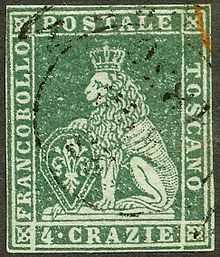Marzocco
The Marzocco is the heraldic lion that is a symbol of Florence, best known in the rendition sculpted by Donatello in 1418–20.
Marzocco was commissioned by the Republic of Florence for the apartment of Pope Martin V at Santa Maria Novella, where this traditional insegna of communal republican defense[1] stood guard atop a column at the foot of the stairs that led to the sale del papa ("Papal apartments") in the convent.[2] The Pope lingered at Florence after leaving the Council of Constance during the Western Schism. The Donatello Marzocco was moved to its present location in Piazza della Signoria in 1812,[3] the ancient original that had stood since 1377[4] in this spot at the end of the bench called the ringhiera, upon which speakers traditionally harangued the crowd, having weathered with time to an unrecognizable mass of stone. The ringhiera, once a platform from which the Signoria addressed the people, then a focus for popular tumult, was removed at the same time.

The obscure name Marzocco, unfathomable to some scholars, would by others derive from Marte (Mars), whose Roman statue, noted by Dante[5] and carried away by a flood of the Arno in 1333, had previously been Florence’s emblem.[6] The lion is seated and with one paw supports the coat-of-arms of Florence, the fleur de lys called il giglio, the lily. Marzocco was` invoked in the Florentine battle cry and figures in Gentile Aretino's poem "Alla battaglia":
"San Giorgio,[7] Marzoccho Marzoccho
suona percuoti, forbocta rintoccho
legagli strecti e pon lor buona taglia!"[9]
Palle palle,[8] Marzoccho Marzoccho
The Marzocco was such a powerful symbol of the Florentine Republic that the republican Florentine troops in the Siege of Florence (1529–1530) were known as marzoccheschi, "sons of the Marzocco",[10] and pro-Medici besiegers of the city in 1530 held a funeral and ritually buried a representation of it, with bells tolling.[11] At Anghiari, subject to Florence from 1385, the 15th-century Palazzo del Marzocco faces the church; at Montepulciano stands the Marzocco column; at Volterra the Marzocco stands against the Palazzo dei Priori, seat of government; at Livorno the 15th-century Torre del Marzocco (illustration, right) guards the harbor entrance; and at Pietrasanta there are a 16th-century Marzocco fountain and the Marzocco column, erected in 1513 when Pope Leo X awarded the commune to Florence.

In the subjected territory of Pisa, when Charles VIII of France entered Sarzana in 1494, the Pisans took the Marzocco, emblem of their subjugation to Florence, and cast it into the Arno.[12] Live lions were kept at the commune's expense from the Middle Ages until they were banished in 1771.
At times the Marzocco would be crowned according to a motto by the writer of novelle Franco Sacchetti:
"Corona porto, per la patria degna,
Acciochè libertà ciascun mantegna."[13]
The crown, emphasizing the sovereign independence of Tuscany, appears on the Marzocco in Tuscany's first issue of postage stamps, 1851.
A richly sculptural socle with double baluster-like motifs[14] at the corners was provided for the Marzocco about 1460.
Donatello’s original, sculpted in the fine-grained gray sandstone of Tuscany called pietra serena, has been conserved in the Bargello since 1855. The version still exposed to weather in Piazza della Signoria is a copy.
Il Marzocco was adopted for the name of a progressive weekly literary review in broadsheet format published in Florence in 1896–1932.
See also
- The Medici lions
Notes
- ↑ Deliberations on the placement of the comparably Cock symbolic Michelangelo's David included suggestions that it displace the Marzocco, to be shifted to the doorway of Palazzo della Signoria: see Saul Levine, "The Location of Michelangelo's David: The Meeting of January 25, 1504" The Art Bulletin 56.1 (March 1974:31–49) especially p. 42.
- ↑ Donatello's original Marzocco
- ↑ Touring Club Italiano, Firenze e dintorni (Milan) 1964 pp. 116, 170.
- ↑ "A still earlier Marzocco stood on this site, which the Pisan captives were forced ignominiously to kiss in 1364. The origin of the name Marzocco is unknown." Augustus Hare, Florence (on-line text).
- ↑ Dante,Inferno XIII.146f, Purgatorio XXXI.58f.
- ↑ Lo Zingarelli 2008: Vocabolario della lingua italiana, Zanichelli (2007).
- ↑ The war cry of the Republic of Genoa, which had Saint George as its patron.
- ↑ The palle or balls of the Medici coat-of-arms.
- ↑ "Sound the trumpets! beat the drums! ...Bind them fast and hold them to a good ransom:" discussed and printed by Timothy J. McGee, "'Alla Battaglia': Music and Ceremony in Fifteenth-Century Florence" Journal of the American Musicological Society 36.2 (Summer 1983:287–302).
- ↑ Noted in Ulysse Robert, Philibert de Chalon, prince d'Orange, vice-roi de Naples (Paris: Plon-Nourrit) 1902:374; Benedetto Varchi, Storia fiorentina xlv remarks upon a severe skirmish with them, "una piuttosto battaglia che scaramuccia co'Marzoccheschi".
- ↑ Richard C. Trexler, Public Life in Renaissance Florence (Academic Press) 1980, p. 4 note 9, drawing upon Benedetto Varchi xi.
- ↑ Encyclopaedia Britannica 1911, s.v. "Pisa"
- ↑ "I wear a crown worthy of my country, in order that everyone might maintain liberty", according to the translation in Susan and Joanne Horner, Walks in Florence: Churches, Streets and Palaces London, Henry S. King & Co., 1877 (on-line text).
- ↑ "Resembling pairs of handleless all'antica urns arranged like the bulbs of a Roman candelabrum", according to Paul Davies and David Hemsoll, "Renaissance Balusters and the Antique" Architectural History 26 (1983:1–122) p. 4.
Sources
| Wikimedia Commons has media related to Marzocco. |
- McHam, Sarah Blake, Looking at Italian Renaissance Sculpture, ch. "Public Sculpture in Renaissance Florence" (Cambridge University Press, 1998; paperback edition, 2000)
| ||||||